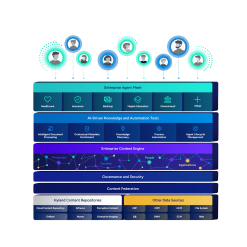
When consumers think about insurance, they might have visions of security, bills that need to be paid — and possibly amusing commercials involving ducks, professional athletes and fears of becoming our parents.
Insurers, on the other hand, are consumed with rising costs, increasing regulatory pressures, heightened customer expectations and surging competition.
Insurance, after all, is an industry built on the certainty of uncertainty. Technology, when deployed effectively, can ease quite a bit of the burden, but also brings disruption to an industry that’s largely risk-averse.
How can insurers best prepare for the road ahead?
Datos Insights, in partnership with Hyland, outlined some key steps in a whitepaper that outlined seven priorities for the innovative insurer.
Here are four key takeaways from the research of Stuart Rose, a strategic advisor at Datos Insights.
1. Give the people what they want
Know your audience. It’s an objective that can apply to any industry — and one that’s often a weakness for insurers.
“Insurance companies have always struggled with how and when to engage with their customers,” the Datos Insights report says. “Despite all the progress made in recent years on knowing your customers better, most carriers fall short of providing a unified omnichannel experience.”
By effectively deploying artificial intelligence, machine learning, robotic process automation and other technologies, insurers can interact with their customers across multiple channels. That’s critical, as consumers, who are accustomed to getting push notifications about such things as food deliveries and news about their favorite teams, expect quick responses to their inquiries.
In short, they want what they want, when they want it.
“For insurance organizations to transform the customer experience, content must be dynamic, interactive, persuasive, and, most importantly, timely,” Datos Insights says.
2. You can’t soar without the cloud
Insurers, Datos Insights notes, are finally welcoming a cloud-first approach.
A June 2021 report that was published by the advisory firm showed 75% of insurers planned to expand their use of cloud computing in the next 18 months. Doing so can free them from having to manage the software and provides access to new capabilities. That falls in line with priority number one: delivering a more personalized experience.
The Datos Insights whitepaper illustrates how insurers have embraced the cloud for portals or digital engagement (63% said they were on the cloud in some fashion) and analytics (55%). The research, though, showed plenty of areas for potential improvement.
Of the insurance CIOs surveyed by Datos Insights, only 35% said they were on the cloud in some fashion for billing. The cloud numbers also were low for claims (37%). On the positive side: 31% of the CIOs said they were actively considering or piloting cloud solutions for claims, and the share was similar for billing (30%).
“Within the last five years, insurers have gone from being skeptical of cloud computing to fully embracing a cloud-first mentality,” Datos Insights says.
3. Artificial intelligence is the real deal
So. Much. Data.
Today’s consumers are always connected, whether it’s via smartphone or watches that track their sleep patterns, steps, heart rates and blood sugar levels.
The true value of data to insurance companies is “being able to use it for fast, fact-based decisions that lead to real business value,” Datos Insights says.
That’s why AI, and intelligent automation in insurance more broadly, can be a game-changer for the industry. The challenge, however, for insurers is integrating AI with core systems and processes.
Datos Insights outlines four steps insurers can take to successfully deploy AI and advanced analytics. One — regularly evaluating the technology — is something many insurers don’t think about until it’s too late.
Read more > How Agentic AI could transform insurance operations
4. The underwriting process is being reimagined
“Life insurance underwriting is at an inflection point,” Datos Insights says.
Sales have steadily declined, and insurers have to make it easier to issue policies. Life insurance policies, unlike property and health insurance, are usually long-term contracts, which places more emphasis on a thorough, effective underwriting process.
Speed-to-issue is a crucial differentiator for life insurers, who still must protect themselves and manage costs. APIs and cloud-based solutions can help insurers manage the influx of data, and AI-driven models can significantly assist in assessing risk.
The underwriting process has to be a mix of “rapid adoption, experimentation, and building systems, processes and roadmaps that allow flexibility for future improvements,” Datos Insights says.
Navigating the road ahead
There are plenty of other interesting nuggets — including tips on winning the race against fraud and making first impressions last — in the report.
Innovating isn’t easy, Datos Insights stresses, and it doesn’t happen overnight.
We encourage you to stay informed and up-to-date, and remember that Hyland’s content innovation solutions can provide a complete view of the information your organization needs, when and where you need it.










